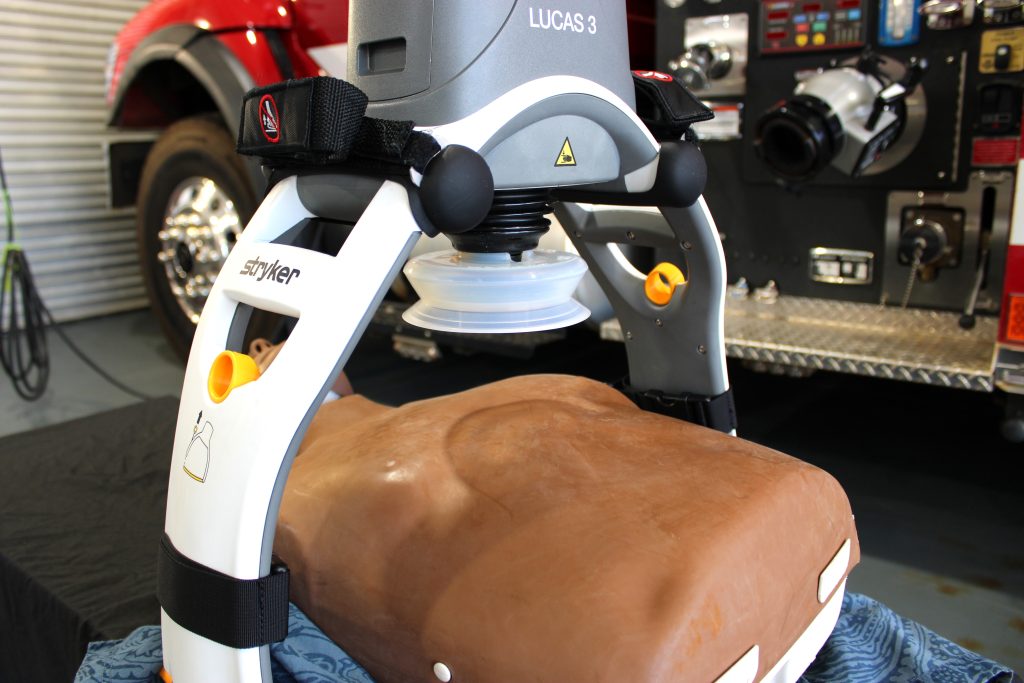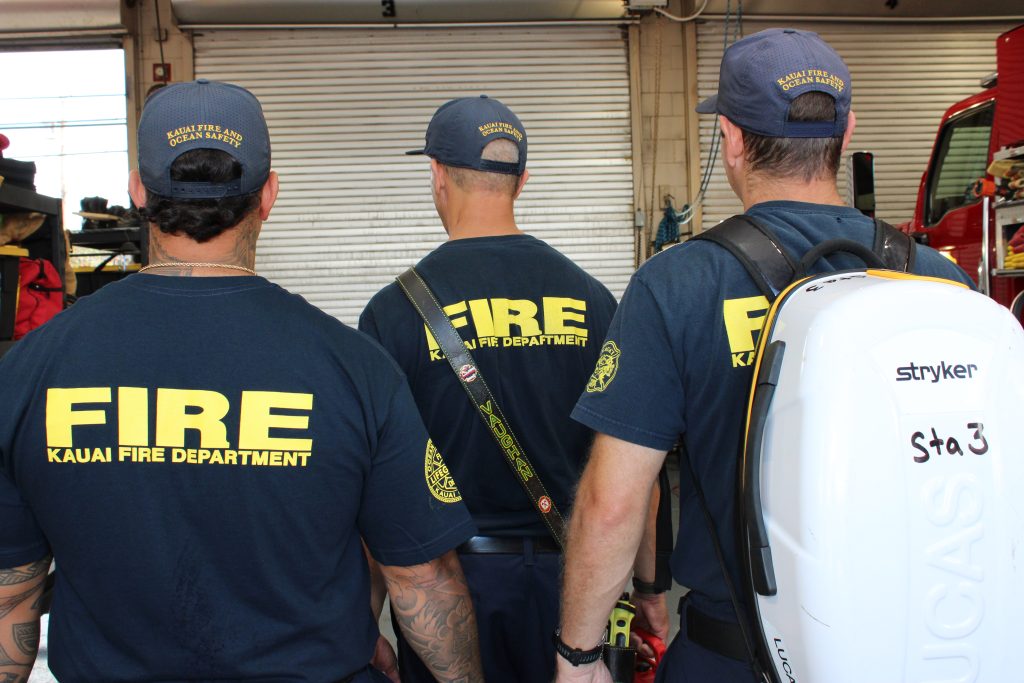CPR robots help Kauaʻi firefighters save lives
Last week, firefighters from the Kauaʻi Fire Department responded to a location in Līhuʻe to find an elderly woman who was unresponsive, not breathing and without a pulse.
She was in cardiac arrest. Her heart had stopped pumping blood. CPR was needed immediately to artificially distribute blood to her vital organs.
The firefighters, who are trained Emergency Medical Technicians, began manual CPR. They attached an Automated External Defibrillator. Next, they hooked up a Lucas device and turned the chest compressions over to a robot. Yes, a robot.

The Lucas CPR robot is portable, and weighs 25 pounds. It is encapsulated in a hard-shell waterproof backpack carry case, and it goes wherever the rescuers go — down to the beach, up a trail and in the Air 1 helicopter.
The robot is controlled electronically and designed to do high quality chest compressions for as long as needed, which in some cases at remote locations on Kauaʻi can be for 30 minutes or more. The robot does not get tired doing CPR unlike even the fittest first responders.
The robot also can continue to give CPR as a patient is transported on a stretcher. This includes while being transported on a trail or other remote locations.
In late 2021, an anonymous donor provided funding to the nonprofit Friends of Kaua’i Fire Department to purchase eight of the approximately $20,000 devices — one for each Kauaʻi County-owned fire station.
The donor “has had a personal experience with cardiac arrest”, and has gifted an unnamed number of Lucas devices to rescue crews across the country, Kaua’i Fire Chief Michael Gibson said.
At first, many of the Kauaʻi firefighters and paramedics were skeptical that a robot could do a better job than a trained human, but Gibson said the device has been a game-changer.
It provides “the best opportunity to survive” for people having cardiac arrest, he said.
The Lucas CPR manufacturer, Stryker Medical, said the device provides 2-to-3 times the blood flow of manual CPR. A study in the World Journal of Medicine showed this extra flow during cardiac arrest is one of the keys to survival.
The robot is assembled by placing a slightly-curved back plate underneath the upper back, and then attaching the battery-powered compression plunger on top. Straps built-in to the device then secure the patient in place. The device takes only about 10 seconds to attach and be ready to perform chest compressions.
It didn’t take long for the skeptics at the Kaua’i Fire Department to turn into believers, with the help of an endorsement by a senior fire captain at the Hanalei station who used the robot, Gibson said.
After three months of training in early 2022, all eight devices were brought online in June of that same year. Since then the devices have been used multiple times. Data on the exact number and how well they have worked is still being compiled.
Gibson said his experience with the Lucas CPR device has changed the way he feels about manual CPR performed by a human. “If it were me that needed CPR, I would want that device on me as soon as possible,” he said.
Captain Kilipaki Vaughan, a 20-year veteran of the department, called the device “a piece of magic. It allows me to pay more attention to the family members at the scene, and to do my job as the leader of the crew, and make sure we are giving emotional support to those family members.”
Using a CPR manikin, Kaua’i firefighters demonstrated how they normally respond to medical emergencies. They asked the mock patient if he was OK, then performed manual CPR briefly, before strapping on the Lucas CPR device. Once in place, the machine began delivering precise, steady, chest compressions via a plunger with a rubber cup on the end.
The Lucas device has been shown to dramatically reduce firefighter fatigue by automating the most physically demanding part of CPR – chest compressions.
The Lucas device also delivers more consistent compressions than manual CPR, keeping the “off the chest time,” to an absolute minimum. To be effective, compressions must be performed at the correct rate and depth throughout the cardiac arrest without stopping. A peer-reviewed study published in the National Library of Medicine show this is another key to successfully resuscitating cardiac arrest victims that survive and are eventually released from the hospital.
Each year, 436,000 Americans die from sudden cardiac arrest, and more than 350,000 of these deaths occur outside of the hospital. In Hawaiʻi, EMS teams treat nearly 1,100 cases of out-of-hospital cardiac arrest each year, with a survival rate of just 9 percent, according to the American Heart Association.
This makes cardiac arrests a leading cause of death in Hawaiʻi. Many of those patients die because they didn’t receive timely CPR. Making that statistic even more sad is that nearly 4 out of 5 sudden cardiac arrests happen at home and are witnessed by a loved one.
The Lucas device is expected to improve those statistics.
“As soon as you put it on and set it up, you know that you have consistent, high-quality CPR,” said Kahao Osaka, an eight-year veteran firefighter with the department. “We pride ourselves in giving the best care that we can, and this helps us to deliver that.”
That was the case for the recent elderly woman having a heart attack. A life-saving shock from the defibrillator was not indicated because she was in asystole, or flatline, meaning the electrical and mechanical activity of her heart had stopped. She would not have benefitted from a shock.
The patient’s only hope for survival was high quality CPR – and that is exactly what she received with the Lucas CPR robot, said Lance Dettle, one of the firefighters caring for the woman.
“The Lucas allows us to ensure consistent compressions, even if we are in a remote area, or we need to move or transport the patient,” he said. “We strapped on the Lucas and after a few minutes of compressions, we could see the pink color returning to the patient’s face.”
Paramedics arrived a few minutes later and Lance rode to the hospital with the patient and pumped air into her lungs, while the robot did CPR without stopping. As her care continued at the emergency department, rescuers stopped the robot.
The woman’s heart had started beating on its own.









